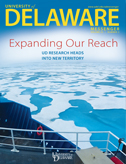Exploring the Arctic—one of Earth’s last great frontiers
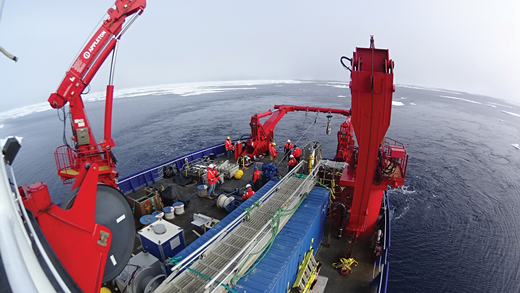
The melting of Arctic ice has been a subject of discussion and debate for decades.
Who owns this greatly unexplored Arctic territory—and its natural resources? As climate change continues to transform solids into liquids in this last great frontier, new geopolitical challenges and concerns are emerging—about ownership, about national security, about precious natural resources and environmental conservation in our shared world.
A rapidly changing environment
Glacial ice in the Arctic is receding—melting— twice as fast as a decade ago. Scientists predict the waters could be ice-free for much of the summer by 2030.
For scientists like the University of Delaware’s Mohsen Badiey, the accelerated environmental changes in the Arctic are driving a critical need to understand what these changes will mean for communicating in this icy region, both for humans and for their marine mammal counterparts.
“We are at a pivotal moment; one that won’t wait,” says Badiey, acting dean of UD’s College of Earth, Ocean, and Environment (CEOE) and professor of physical ocean science in the School of Marine Science and Policy (SMSP).
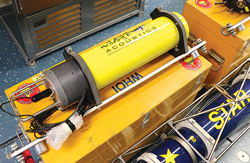
Supported with funding from the Department of Defense Office of Naval Research, Badiey is studying how acoustic signals—sound signals—travel in the Arctic. From a national security perspective, his research is becoming increasingly important as nations consider how to navigate and communicate undersea in these previously inaccessible territorial waters, particularly for shipping or resource exploration (think oil), which require acoustic signals to navigate, map the sea floor and communicate underwater.
“Whenever there are economic incentives, there are defense incentives because we need to protect assets and pathways,” says Badiey, who is collaborating with Andreas Muenchow, an SMSP associate professor, on the project.
The science of sound
But to understand communication in once-uncharted waters, we need to understand the basics of acoustical science.
Sound is an invisible form of energy created when vibrations travel from one point to another. Acoustics is the science of sound—the physics surrounding how sound is produced, controlled, transmitted and received in a given environment.
Marine mammals such as whales and dolphins use sound signals for communication. Dolphins also use sound—via echolocation—to determine how far away they are from objects in the ocean.
Similarly, how sound moves through different bodies of water can tell scientists a lot about the ocean environment. For example, sound waves travel four to five times faster in water than they do in air. Sound also travels faster through warm water and slower in cold, salty water.
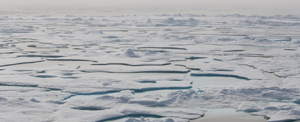
But while advanced technology can transmit an email across the globe in a matter of seconds, technology to communicate underwater has lagged as much as 15 years behind land-based communications. This is due to electromagnetic waves—like those used in cell phones, Xrays and radar—which don’t penetrate in seawater, making sound waves the only means for scientists to communicate underwater.
Decoding the Arctic
During a pilot experiment this summer, doctoral student Justin Eickmeier, EOE16, who studies acoustical oceanography under Badiey’s advisement, traveled to the Beaufort Sea, approximately 200 miles north of Prudhoe Bay, Alaska.
There, along with colleagues from Woods Hole Oceanographic Institution and the Scripps Institute of Oceanography, he deployed UD acoustic receivers and sensors on the U.S. continental shelf to record background sounds coming from the deeper waters. The UD receivers recorded sound samples continuously for three weeks, while environmental sensors monitored how the water temperature and saltiness changed at different depths over time.
“It is important for students to see science in action,” says Badiey. “This Arctic project was the perfect opportunity for Justin to gain hands-on research experience and network with scientists from other institutions.”
As part of the experiment, the Scripps researchers attempted to transmit underwater communication signals from equipment located in the deep waters of the Arctic Circle to the UD receivers in the Beaufort Shelf. The big question was whether the signals would successfully travel so far under the ice, and whether Eickmeier would be able to both receive and decode the signals. (This can be challenging because as sound signals travel under ice they can bounce around, lose energy and become more difficult to hear. Sometimes they are even distorted.)
Within two days of retrieving the equipment from the icy water, Eickmeier had his answer.
“The answer is yes, and from farther than we thought was possible,” he says.
In fact, the sound signals had traveled more than 80 miles. Even more important than the distance travelled was the large change in the water’s depth, from approximately 9,840 feet below the surface to 524 feet—that’s over six Empire State Buildings deep.
Early results set future direction
According to Eickmeier, while the Arctic region is terribly quiet above the surface, below it is alive with activity and sound. The predominant sound seems to be ice cracking and breaking, which he described as small explosions that sound like wind gusting over a microphone. There are also nearly continuous marine mammal sounds—seals, walrus and whales.
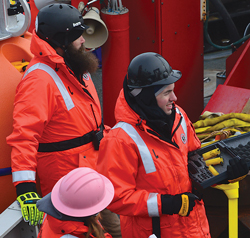
His preliminary data analysis revealed that the Beaufort Shelf region is an excellent site for collecting sound profiles from marine mammals communicating at low to medium frequencies.
The sounds, he said, came from all different directions, distances and depths. Understanding how these marine mammals communicate, and at what frequencies, may help researchers determine an optimal range for acoustic communication in this unknown territory.
An unexpected finding to emerge from the pilot study’s temperature data was the cold layer of water, which appeared to be sandwiched between two warmer layers in the study region. This warm-cool-warm division creates distinct traveling parameters for the acoustic sound waves and can potentially change the sound’s volume or intensity, Eickmeier says.
The scientists will launch a comprehensive, yearlong study beginning next summer to evaluate how the Arctic’s ocean environment is changing, and specifically, how seasonal changes in temperature and salinity affect sound transmission.
Their results also could have important implications for the design of underwater communication systems necessary for operation of undersea robots and autonomous underwater vehicles. Having sensors recording continuously over a year will also provide important information about how marine life in this region use the ocean environment, which could have policy implications for conservation, among other things.
Other budding questions include whether the animals recorded remain in this area of the Arctic all year or only seasonally, whether they travel alone or in groups, and whether the presence of man-made devices will affect their natural habitat.
Future environmental changes in temperature and seasonal ice coverage in the Arctic will likely affect the animal species that live there and subsequently the people who depend on marine life for their livelihood.
“We all have a vested interest in this area of the world,” says Badiey.
Article by Karen B. Roberts, AS90
Expanding our understanding of the Earth, ocean and environment
The remote corners of the Arctic have become an extension of the UD campus, as faculty from the College of Earth, Ocean, and Environment (CEOE) extend their research to this vast region. Current projects addressing globally consequential questions include:
Andreas Muenchow and CEOE doctoral student Peter Washam are part of an international research team working to document changes in the grounded Petermann Glacier, which connects the great Greenland ice sheet directly with the ocean. As part of a U.S.-Swedish expedition, this summer the researchers deployed sophisticated sensors to capture the first-ever temperature, salinity and tidal motion measurements of the ocean underneath the glacier.
Mark Moline and Jon Cohen are studying how marine organisms cope with prolonged winter darkness in the archipelago Svalbard, north of mainland Norway. As part of an international research team, Moline and Cohen are using unmanned underwater vehicles and other environmental technology to study how marine organisms—such as krill and sea jellies—perceive light, and how they use it to find food, to avoid predators and to mate.
A UD team led by Cathleen Geiger collaborated with the Naval Academy’s Oceanography Department in 2013 to study changes in Arctic sea ice. The UD researchers, who included Tracy DeLiberty, combined measurements taken underwater, in the air and from space to evaluate and monitor changes in the ice. Some practical applications for the information include mapping walrus habitat, improving ship navigation and aiding in search-and-rescue operations.
Neil Sturchio is exploring how the thawing of permafrost—a subsurface layer of soil that remains mostly frozen throughout the year—affects vegetation and the carbon cycle in the Toolik Lake area of Alaska’s North Slope. Understanding the complex balance between the plants, soils, microbes and gases in this layer can help scientists better predict the long-term consequences of global warming.
Dana Veron and colleagues are studying how changes in the air circulation patterns and cloud cover in the Arctic during the early summer influence how much sea ice is left or has melted by September. The work is important for understanding what conditions lead to rapid, large-scale sea ice melt, which contributes to enhanced warming in this region and influences ecosystems and navigation routes.
To learn more about research in the College of Earth, Ocean, and Environment, visit www.ceoe.udel.edu/research.
